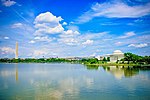Jefferson Memorial

The Jefferson Memorial is a presidential memorial built in Washington, D.C. between 1939 and 1943 under the sponsorship of President Franklin D. Roosevelt. Roosevelt thought that it was a suitable memorial to the Founding Fathers of the United States and to Thomas Jefferson, the principal author of the United States Declaration of Independence and the founder of the Democratic-Republican Party. The neoclassical building is situated in West Potomac Park on the shore of the Potomac River. It was designed by John Russell Pope and built by Philadelphia contractor John McShain. Construction began in 1939 and was completed in 1943. The bronze statue of Jefferson was added in 1947. Pope made references to the Roman Pantheon whose designer was Apollodorus of Damascus, and to Jefferson's own design for the rotunda at the University of Virginia. The Jefferson Memorial and the White House form one of the main anchor points in the area of the National Mall in D.C. The Washington Monument was intended to be located at the intersection of the White House and the site for the Jefferson Memorial, but soft swampy ground required that it be situated to the east.The national memorial is managed by the National Park Service of the Department of the Interior under its National Mall and Memorial Parks division. In 2007, it was ranked fourth on the "List of America's Favorite Architecture" by the American Institute of Architects.
Excerpt from the Wikipedia article Jefferson Memorial (License: CC BY-SA 3.0, Authors, Images).Jefferson Memorial
Ohio Drive Southwest, Washington
Geographical coordinates (GPS) Address External links Nearby Places Show on map
Geographical coordinates (GPS)
| Latitude | Longitude |
|---|---|
| N 38.881388888889 ° | E -77.036666666667 ° |
Address
Jefferson Memorial (Jefferson Memorial)
Ohio Drive Southwest
20228 Washington
District of Columbia, United States
Open on Google Maps











